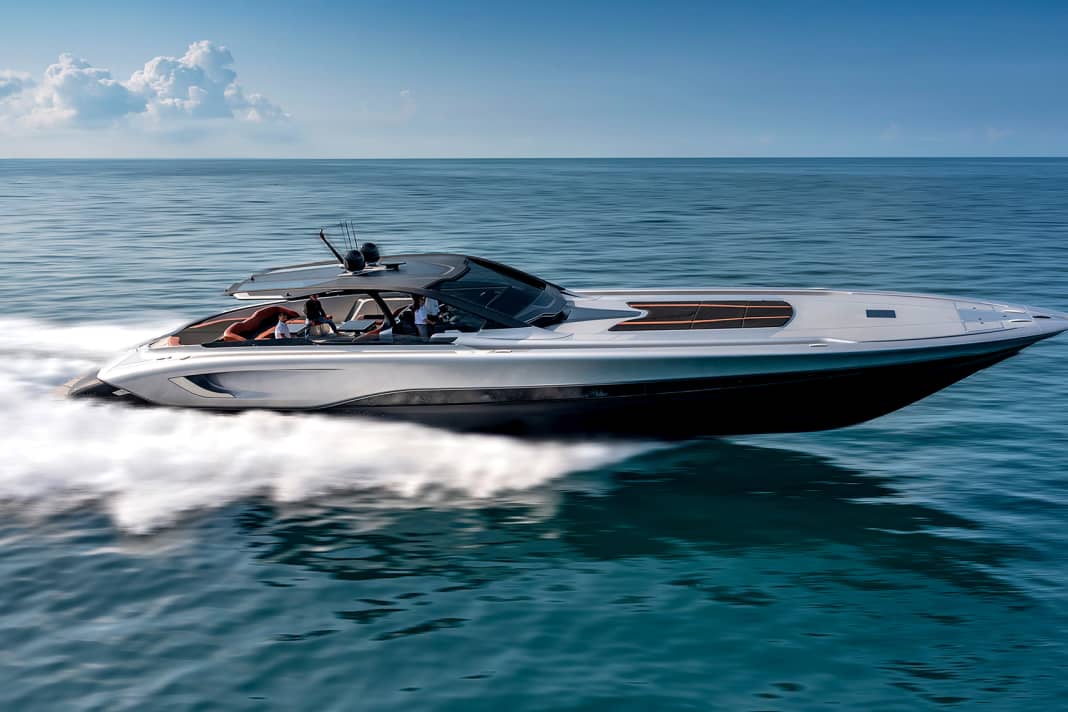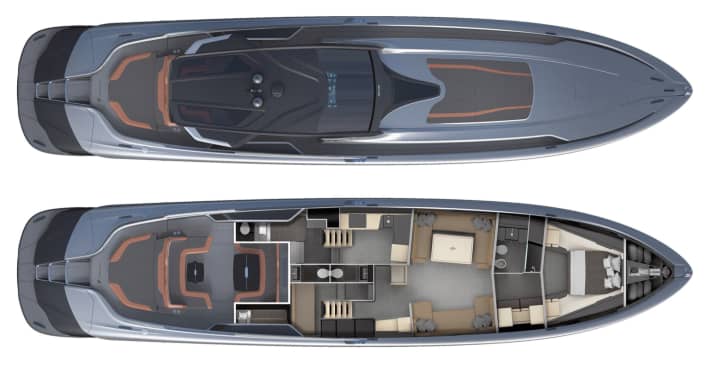Bolide 80: The world's fastest yacht is being built in a pop-up shipyard
Christian Sauer
· 24.02.2024






Have you ever "flown" across the water at 60 or 70 knots and how did you feel - safe and secure, relaxed? If you have had this special experience, you were probably on board a thoroughbred racing or super sports boat. Driving comfort probably played just as secondary a role as a luxurious interior, unless the hull was completely empty. At least that's what our experiences in the editorial office reflect when we enjoyed such fast test drives on board various formats, not only there, but above all during the Cannes Yachting Festival. "Breathtaking" seems almost an understatement when describing what we have experienced on the water at over 110, 120 or even 130 km/h in recent years. It didn't always bring a smile to the faces of even colleagues with decades of experience, but rather made them pale and even brought a sweat of fear to their foreheads. At least there was no threat of that when we visited the Principality at the end of September.
An Italian spoilt by speed gave the order
While the Bolide 80 had unfortunately been conspicuous by its absence in Cannes a few weeks earlier and was therefore unable to demonstrate its dynamic potential, at least it made its static debut at the Monaco Yacht Show. The 24.90 metre long world premiere, parked between the floating gigayachts of the well-known manufacturers and the latest Wallys in Port Hercule, looks both perfectly right and yet out of place. On the one hand, this is due to its own claim to be a real yacht in many respects, which we will come back to later. On the other hand, with her 5.40 metre slim, aerodynamically optimised design, she does not appear to be moored in her preferred element, but rather waiting impatiently for the next full-throttle exit. And that was precisely the intention of the experienced owner from Italy, who had previously
owned several boats from Cigarette Racing and Magnum. Tired of the traditional design of those boats, he was looking for something more modern and a yacht with a top speed of at least 70 knots! It was also important to him to be able to cruise "relaxed" at over 50 knots rather than 38 or 40 knots.
The drive package for the Bolide 80 surprised even the connoisseurs
"Many in the industry were sceptical - not only because of the required maximum speed, but also because it was not to be achieved by water jet, but with surface propulsion and diesel engines," reports Brunello Acampora, founder of Victory Design based in Naples. "We were very interested in the project. It is of course a very small niche market, but the challenge of building the fastest yacht in the world was extremely appealing to us." Acampora worked out a promising concept free of charge, with which he directly convinced his speed-loving compatriot and was also awarded the construction contract. However, for the design studio, which has been producing prototypes and pre-series models for three decades, the commission presented a major challenge: "But we were lucky that the America's Cup had just been cancelled and the best carbon experts were available."
The pop-up shipyard works together with experts
This allowed Acampora to put together its dream team and rent space at the Seven Stars shipyard right next to the Mangusta halls and the airport in Pisa in 2019. The pandemic also caused delivery problems, interruptions and delays at the pop-up shipyard. But the Italians were not deterred and completed their masterpiece with three MAN twelve-cylinder engines, each with a capacity of 24 litres and 1471 kilowatts. In May 2023, the Bolide 80 finally entered the water and was allowed to make its first test runs. "The boat exceeded all project targets - both in terms of top speed at over 70 knots and at cruising and partial speeds," comments Massimo Bruni, Technical Director at Victory Design, adding: "Thanks to Dihedral's innovative rudder system and Xenta's active steering system, the tests confirmed the boat's perfect manoeuvrability at all speeds."
The patented T-Drive propulsion system from Flexitab, proven in racing boats, including trim tabs and automatic mode, together with the two independent rudders, not only simplifies steering. The latter also function like foils and enable impressive consumption values and ranges. During our visit on board, Brunello Acampora was happy to point out that the three MAN V12-2000 engines only use 13.7 litres of diesel per mile at 1800 rpm and an impressive 53 knots. At the high cruising speed, this consumption value is much more significant than the 729 litres of diesel per hour and significantly lower than that of comparably long yachts at much lower speeds. Thanks to the 6500 litre diesel bunker, the sporty 28-tonner has a range of 472 nautical miles. No less remarkable are the 389 nautical miles when 2400 rpm and 76 knots top speed are displayed on the digital XL instruments in the helm station, which is protected from the wind and sun. Diesel consumption then settles at 1268 l/h or 16.6 l/sm. Also superlative regions.
Ultralight carbon construction in its purest form
These fabulous values are also thanks to the multi-stage hull shape developed by Victory, which generates extremely low frictional resistance during the fast ride, as well as the elaborate lightweight construction. The carbon fibres produced by Microtex, together with the structural cores specially developed by Diab, also ensure extreme rigidity. These carbon elements are directly connected to the hull and deliberately kept visible below deck. For the first Bolide 80, which regularly travelled between Ibiza and Formentera in the summer, the owner opted for a layout with a galley on the port side, which is easily accessible from the cockpit via the companionway. The parallel companionway to starboard leads to the TV lounge, which can be converted into a guest or children's cabin if required. Its bathroom with carbon toilet and cognac-coloured lacquered marble veneer also serves guests on board during the day. A further cabin in the stern is reserved for the captain. The owner's suite with queen-size bed is located in the bow, behind which is the spacious saloon. A dining table on the port side seats eight guests, while the owner has ordered a desk with two integrated displays opposite.
Exposed carbon fibre and leather in Hermès orange dominate on board the Bolide 80
As a contrast to the carbon fibre and the matt black lacquered surfaces, interior designer Stefano Faggioni from La Spezia, who previously worked mainly on classic sailing yachts, worked with Victory's in-house design team to use cognac-coloured leather and natural fibres such as linen, cashmere and silk, including from Loro Piana. The wardrobes are deliberately reminiscent of historic leather trunks and, like the entire interior, impress with their high-quality workmanship. The headroom is a pleasant surprise for a yacht of this category and these dimensions - despite the dominance of dark materials, the rooms appear spacious and inviting. If desired, the skylight and hull windows let in plenty of daylight. Alternatively, the LED lighting in the curved ceiling panels illuminates the saloon or allows the furniture to float on light.
The entrance to the owner's cabin is flanked on the port side by the bathroom with a generously proportioned shower, carbon toilet and bidet. Opposite is a walk-in wardrobe, which forms an elegant ensemble with two cupboards, a central sideboard and the leather bench seat. Striking patterns in the leather surfaces are inspired by the Italian master of patterns, Lucio Fontana. The queen-size bed in the "pole position" appears to float on the two drawers below, while a pearl grey silk carpet caresses the feet. This is where the Bolide 80, which costs a good ten million euros and of which a limited small series of ten is planned, proves that it is not only an exceptionally fast boat, but also an extremely comfortable yacht. But Brunello Acampora and his team are not planning to stop there - further speed concepts up to 170 feet in length are already in the pipeline.
Technical data


- Length over everything: 24,90 m
- Length (hull shape): 18,00 m
- Width: 5,40 m
- Depth: 0,90 m
- Displacement (empty): 27,9 t
- Material: Carbon
- Motors: 3 x MAN V12-2000
- Engine power: 3 x 1471 kW
- Speed (max.): 76 kn
- Speed (travelling): 53 kn
- Generators: 2 x Cummins Onan 40 kW
- Fuel: 6500 l
- Water: 1500 l
- Navigation: Böning, Raymarine
- Construction: Victory Design, Massimo Bruni
- Exterior design: Victory Design
- Interior design: Stefano Faggioni, Victory Design
- Class: CE 94/25 B
- Shipyard: Bolide Yachts, 2023
- Starting price: 10.5 million euros

